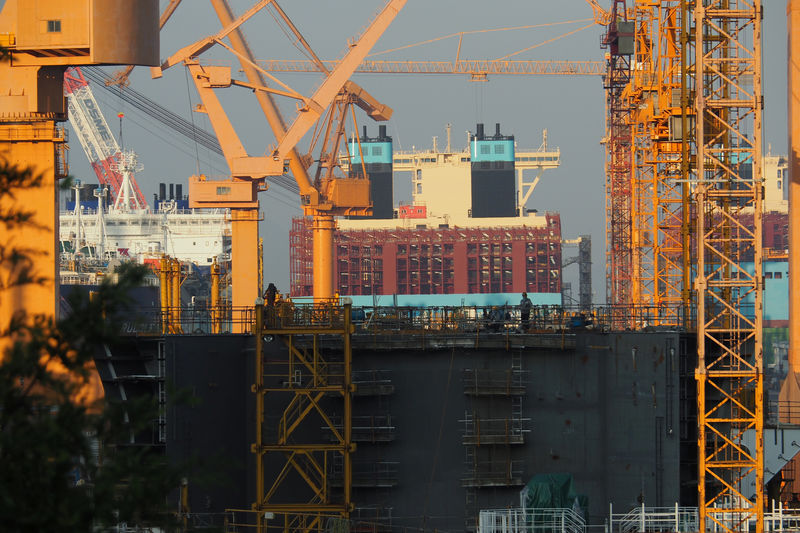By Henning Gloystein and Jane Chung
BUSAN/SEOUL (Reuters) - Sparks light up the night-shift at giant shipyards on Korea's southeast coast, as welders and fitters at some of the world's biggest marine engineers forge next-generation container ships, oil rigs and even ice-breaking tankers in a bid to clamber out of a global industry abyss.
Sunk by drastic cuts in orders from customers hit by the 2008 financial crisis, South Korea's shipping landscape has been littered with bankruptcies and billion-dollar losses. But some, like Busan's DSME, are adding innovation to craftsmanship to tap new demand for nimbler ships and offshore energy platforms.
The stakes are high for South Korea, jostling with Japan and China to lead an industry revival. Global orders - the trio account for four of every five merchant vessels built - grew nearly two-thirds during the first nine months of the year from a year earlier, according to shipping research firm Clarkson.
In September alone, South Korean yards bagged half the business, Clarkson's data shows.
"After years of struggle, we're finally seeing some growth," said Adam Kent, director at consultancy Maritime Strategies International (MSI), speaking during the Kormarine industry event in Busan last week. "Earnings for most shipping sectors have improved from their recent historic lows and are expected to gradually improve."
The crisis hit bottom earlier this year with the bankruptcy of Korea's Hanjin, one of the world's biggest shipping companies.
But DSME - Daewoo Shipbuilding & Marine Engineering <042660.KS> - is now back from the brink of collapse a year ago. This week its shares resumed trading after over a year's suspension, slumping before stabilizing at a level that still gives it a market value of about $1.7 billion.
In what's seen as a lifeline, DSME in September received an $820 million container ship order from Europe, its biggest in two years.
"It's hard to say the shipping market conditions have fully recovered, but the situation is much better than last year," said Yohan Yoon, deputy general manager at DSME's communications department.
INNOVATE OR DIE
Tens of thousands of employees work day and night at South Korea's big three shipyards - Hyundai Heavy Industries (KS:009540), Samsung (KS:005930) Heavy Industries (KS:010140) and DSME - building dozens of mega-tankers, container giants and huge oil and gas production platforms at once.
Based on the southeastern tip of South Korea, at the confluence of the Yellow Sea and waters off the east of the Korean peninsula, the trio has racked up billions of dollars in losses, prompting major restructuring in the face of stiff competition from its Chinese and Japanese rivals.
The years of pain have made innovation all the more essential.
"We have to become much smarter and more efficient in order to build better ships," Yoon So Park, chairman of the Korea Maritime Equipment Association, also speaking in Busan.
Improving shipping efficiency or even switching to cleaner fuels like liquefied natural gas (LNG) is necessary to comply with regulation coming into effect from 2020 by the International Maritime Organization (IMO).
"We expect demand for environmentally friendly ships to grow in the future especially after stricter IMO measures," DSME's Yoon said.
More recent DSME orders include 15 of a new type of ice-breaking tankers, three of which have been undergoing sea trials just outside DSME's yard at Geoje. The ships, which cost over $300 million each, are understood to be heading soon to Russia to start exporting Arctic Russian LNG from the Yamal peninsula.
NEW MARKETS NEEDED
Barrie Stevens, senior adviser to the Ocean Economy Programme at the Organisation for Economic Co-operation and Development (OECD), said South Korea remained the leading shipping innovator.
"Korea stands out in terms of ship sector patent applications," said Stevens, in Busan for the Kormarine event.
To survive in the long-term, OECD's Stevens said the industry would need to seek out openings in new sectors, including offshore wind power and acquaculture, or fish and seafood farming.
"We are looking at explosive growth in offshore wind. This is a shipping business opportunity," said Stevens.
"Looking further, aquaculture is seeing sharp growth," he said. "Korea has the world's highest aquaculture patent growth, with a share of 35 percent of OECD (member country patents), and a global share of 30 percent. Korea is right on the cutting edge here."
GRAPHIC: Global market share of shipyards by country (2017) http://reut.rs/2gWpLUD
GRAPHIC: Crisis in a chart: DSME shares resume after suspension - and crash http://reut.rs/2gVquW3
